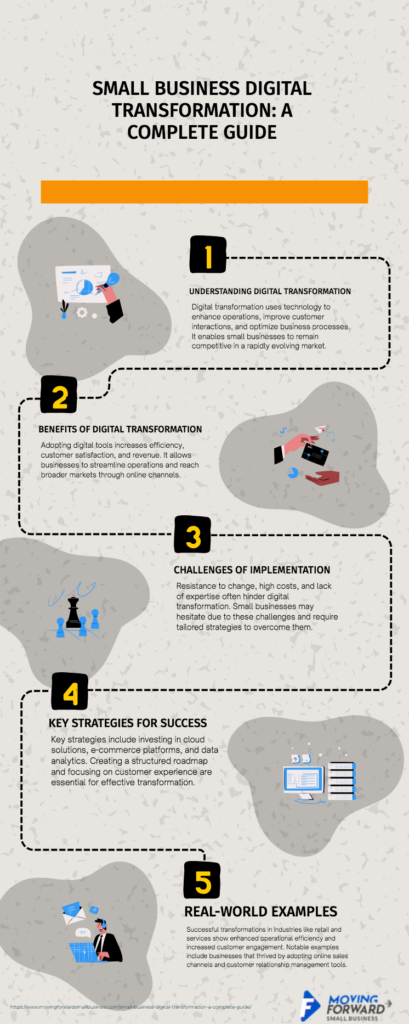Key Highlights
- Digital transformation is very important for small businesses today.
- It means using digital technologies to improve how things work, make customer experience better, and stand out from competitors.
- Important reasons for this change include changing customer expectations, new advancements in artificial intelligence, and the need to make decisions based on data.
- Small businesses can start their digital transformation by figuring out what they want to achieve, using suitable technologies, and creating an innovative work culture.
- To make the most of these improvements, they should track success with KPIs and keep up with changes in technology.
Check out the Complete Digital Transformation Series
- Understanding Digital Transformation for Small Businesses (You are reading now)
- Crafting an Effective Digitalization Strategy
- Digital Transformation Examples to Empower Small Businesses
- Crafting a Successful Digital Transformation Strategy
- Unlocking Customer Experience: Small Business Success
- Data and Analytics Strategies for Digital Transformation
- 10 Innovative Business Model Transformation Strategies
- Mastering Digital Operations for Small Businesses
- Workforce Transformation Strategies for Small Businesses
- Essential Cybersecurity Tips for Digital Transformation
- Top 12 Digital Transformation Tools Every Entrepreneur Needs
- 10 Must-Have Tools for a Successful Digital Transformation for Small Businesses
Listen to the complete audio of this blog
Introduction
In today’s world, technology is changing fast. For small businesses, going digital is important for staying alive and growing. This means adding digital technologies to every part of the business. It changes how businesses work, connect with customers, and compete. By adopting technology, small businesses can become more efficient, focus more on their customers, and be more creative.
The Essence of Digital Transformation in Today’s Business Landscape

Digital transformation is a big change in how businesses work and provide value. It’s about using technology to make processes easier, improve customer experience, and find new ways to grow. Today, businesses face fast changes in technology, changing customer expectations, and tough competition.
To succeed in this fast-paced world, small businesses must see digital transformation as an ongoing journey. They need to adapt and innovate all the time. Just having a website or using social media isn’t enough anymore. Businesses must fully integrate digital technologies into every part of how they operate to stay competitive.

Defining Digital Transformation for Small Businesses
Digital transformation for small businesses means using new technologies in all parts of their work. This changes how they operate and how they provide value to customers through innovative business models. It’s not just about getting new tools; it’s about making business processes more efficient. The focus is on using data and putting the customer first.
By using digital tools and strategies, small businesses can make their operations smoother, automate tasks, and see real-time data insights. This helps them make better decisions, work more efficiently, and react quickly to changes in the market.
In the end, digital transformation helps small businesses improve customer experience, gain a competitive advantage, and boost revenue growth. Digital leaders know it’s about using technology to adapt, innovate, and thrive in the digital age.
Why Small Businesses Cannot Ignore Digital Transformation
In today’s world, customer expectations are really high. Customers want businesses to have a strong online presence. They also want smooth digital experiences and personalized interactions, as noted in the Harvard Business Review. Small businesses that do not meet these needs may lose customers to those who are adopting digital changes.
Additionally, changing digitally can bring a lot of value to small businesses. By automating tasks and using data analytics, businesses can better understand customer behavior. This helps them improve their operations, work more efficiently, and make smart decisions to boost profits.
If businesses ignore digital transformation, they risk falling behind their competitors. Those competitors are using technology to improve customer experience and find new opportunities in the market. Embracing digital transformation is essential not just for staying competitive but also for ensuring success in the future.
Key Drivers of Digital Transformation for Small Enterprises

Several things are pushing small businesses to go digital. First, customer expectations are changing fast. Today’s shoppers are used to easy and quick online experiences in their everyday lives. They want the same speed, comfort, and personal touch from the businesses they deal with.
At the same time, new technologies like artificial intelligence, machine learning, and the Internet of Things are changing how businesses work. These advancements open up great chances for automation, data study, and getting closer to customers. Small businesses that use these technologies will be in a better place to change, create, and succeed.
Technological Advancements Shaping Small Businesses
Technological changes are happening really fast. They are changing how small businesses work and connect with their customers. Artificial intelligence (AI), including generative AI, is no longer just a far-off idea. Now, it is easy for businesses of all sizes to use through simple tools and platforms. This helps automate tasks, customize marketing campaigns, and even create new products.
The Internet of Things (IoT) is another big change. It helps businesses gather and look at data from connected devices. This can improve processes and give real-time insights into business operations. With smart inventory management and predicting maintenance needs, IoT boosts efficiency and brings new ideas to different industries.
Mobile devices have also changed how customers behave. Small businesses must have a strong online presence. This includes ensuring that websites and marketing materials work well on mobile devices. A mobile-first strategy is important to connect with today’s online consumers.
The Impact of Consumer Expectations on Business Operations
Customer expectations have changed a lot in the digital age. Now, consumers want quick responses, personalized experiences, and smooth interactions, no matter the channel. Small businesses see that old ways of customer service are not enough. They need to use digital tools and strategies to improve the customer experience every step of the way.
Social media is very important for shaping what customers expect. It has become a key way for businesses to connect with their audience, solve problems, and build relationships. Having a strong social media presence, along with quick customer service and interesting content, is essential for gaining brand loyalty.
Today, customers want more than just goods or services; they want memorable experiences. Small businesses should focus on creating a complete and customer-focused digital strategy. This should include user-friendly websites, mobile apps, personalized marketing campaigns, and active customer support.
Competitive Advantage Through Digital Innovation
In a tough market, small businesses can use digital solutions to stand out and get ahead. By using digital innovation, they can make their tasks easier, improve customer experiences, and launch new products or services faster than before.
Digital solutions can help them set better prices, manage their supply chains, and reach customers worldwide using e-commerce platforms. This ability to adapt quickly is vital for success in today’s fast-changing business world.
In the end, focusing on ongoing digital innovation helps small businesses stay relevant and meet customer needs. By fully utilizing technology, they can make innovation a major factor for growth and success.

Click image to see the full infographic
Fundamental Areas of Digital Transformation
Digital transformation affects every part of a small business. However, some areas are key to making it successful. One important focus is creating great customer experiences. This means understanding what customers need, making interactions personal, and providing a steady and positive experience through all digital channels.
Another vital area is improving operations with digital processes. Small businesses can use technology to automate tasks, boost efficiency, and get real-time data insights. By using data to make decisions, they can improve their internal processes, lower costs, and increase overall productivity.
Optimizing Customer Experience in the Digital Age
Customer experience is very important in today’s digital world. For small businesses to succeed, they need to make this experience better. To do this, they should create a smooth experience that works well across different digital platforms. This includes websites, mobile apps, social media, and email marketing.
Personalization is also key to improving customer experience. By using data analytics, businesses can understand what individual customers like, their past purchases, and what they look at online. This information can help them create marketing campaigns that fit each customer. They can even offer personal recommendations and tailored messages that connect with customers, building their loyalty and increasing sales.
It is also essential to ask for customer feedback. This can be done through surveys, interactions on social media, and reading online reviews. By paying attention to feedback and taking action on any issues, small businesses can show they care about customer satisfaction. This helps them make changes that improve the overall experience.
Streamlining Operations with Digital Processes
Digital transformation can really help small businesses build a digital business, work better, and save money. By using digital tools, they can automate tasks, cut down on mistakes, and improve their workflow. This means lower costs, quicker service, and more productivity.
In supply chain management, going digital brings big rewards. Using real-time tracking, automated inventory systems, and data-driven logistics can change how businesses handle their supply chains. This makes sure deliveries are on time, cuts down on waste, and boosts customer happiness.
When small businesses use digital tools and automate their work, they can save time and resources. They can then focus on important things like product development, expanding into new markets, and building good customer relationships. This helps with business transformation and growth.
Leveraging Data and Analytics for Strategic Insights
In today’s digital world, businesses have a lot of data. Getting useful insights from this data is important for making smart decisions. Small businesses can use data analytics and business intelligence tools. These tools help them understand customer habits, market trends, and how well they run their own operations.
By looking at data from different places, like website traffic, social media, and sales, businesses can find patterns and what customers like. They can use these insights to make marketing campaigns more personal, set better prices, and create new products that fit what their customers want.
Also, data analytics helps businesses keep track of key performance indicators (KPIs). It lets them see how well their marketing campaigns are working and find out where improvements are needed. This way, small businesses can make better decisions, improve their operations, and boost growth.
Enhancing Employee Engagement and Productivity
Digital transformation affects more than just how a business interacts with customers. It also greatly influences employee experience and productivity. By giving employees the right digital tools and creating a digital-first culture, small businesses can make their work environment more engaging and efficient.
Digital tools like cloud-based platforms, project management software, and communication apps allow employees to work from anywhere, collaborate well, and stay connected. This flexibility helps with work-life balance, improves morale, and helps businesses attract and keep skilled workers.
Still, managing this change is very important. Clear communication, thorough training, and ongoing support regarding process changes are key to helping employees adjust to new digital tools and processes. This helps the entire organization enjoy a smooth transformation.
Practical Steps Towards Achieving Digital Transformation

Starting a digital transformation can feel overwhelming for small businesses. But, with a planned and step-by-step approach, these businesses can handle the change and benefit from it. The first important step is to figure out the digital goals and objectives of the business. This means looking at where the business is right now, what problems it has, and where it wants to be in the future.
After setting clear goals, it’s time to create a plan for digital integration. This plan should list the specific technologies, resources, and timelines needed to reach the goals. This way, the business can implement the changes in a smart and organized way.
Identifying Your Business’s Digital Goals and Objectives
Before starting to use digital solutions, small businesses need to set clear business goals for their digital change. This is important to connect the change efforts to the overall business aims. Having well-defined goals gives a clear path and a way to see how things are going.
First, look at the biggest problems the business faces. Are there issues making growth hard? Are the marketing campaigns not reaching the right people? Is getting new customers too expensive? Once you see these problems, you can turn them into specific, measurable, achievable, relevant, and time-bound (SMART) goals.
For example, one goal could be to boost online sales by 20% in a year or to raise customer retention by 15%. By setting these success goals from the start, businesses can track how well they are doing, make changes if needed, and show the return on investment (ROI) from their digital transformation efforts.
Developing a Roadmap for Digital Integration
Having clear business goals is important. The next step is to create a digital transformation framework. This framework acts like a roadmap. It helps the organization integrate digital technologies into its operations. The framework should detail the key projects, timelines, resources needed, and possible challenges that may come up.
The plan for implementation should have different phases. Start with pilot projects in key areas that were identified during goal setting. A phased approach allows the business to be flexible. It can learn, adapt, and improve its digital transformation strategy as it moves forward.
Getting support from stakeholders at all levels is just as important. Good communication, training, and change management are vital for successfully creating and executing the roadmap.
Selecting the Right Technologies for Your Business Needs
With a clear plan, small businesses can choose the best technologies for their needs and goals. The tech world is large and always changing. It is important to research and check different options before spending money.
Start by looking closely at what you already have. Find out where technology can make things better. Think about your budget, skills, ability to grow, and how well new tech can work with your current systems.
Ask for advice from others in your industry. Talk to technology partners and try out free trials or demos. This way, you can see how different solutions meet your needs. Remember, the right technology should help with today’s issues and support your business’s growth in the future.
Overcoming Common Challenges in Digital Adoption
Digital transformation gives small businesses many chances, but they often face some challenges when they adopt new tech. One big challenge is that employees may resist change. They are used to old ways of working. To help with this, share the clear benefits of digital transformation. Offer good training and support, and be ready to listen to any worries or fears they may have.
Old systems can also create problems. Businesses might be slow to change outdated technology because they worry about costs and how it will affect their work. However, combining new tech with older systems can be tricky and might reduce the benefits of digital transformation. Look for options like step-by-step upgrades, ways to move data easily, or cloud solutions that integrate well.
Lastly, make sure all employees have access to the training and resources they need. Getting used to new technology can feel hard. Providing support through workshops, online guides, or an IT helpdesk can help employees use new tools and processes with confidence.
Success Stories: Small Businesses and Their Digital Transformation Journey

Many small businesses show us how using digital tools can lead to great growth and success. One example is a traditional retail store that had a tough time against big online stores. They started an online shopping site, used social media to promote their brand, and made their customer interactions more personal. As a result, they saw a big increase in sales and gained more customers.
Another example is a small factory that used data analytics to improve how they made products. By tracking and studying real-time data from their machines, they cut down on delays, improved product quality, and increased profits. These stories show us how digital technologies can change small businesses for the better.
Case Study 1: Boosting Sales Through E-commerce Integration
A family-run bakery had served its loyal customers for many years. They noticed they were missing out on more customers because they only had a small shop. To change this, the bakery decided to use e-commerce. They created a simple website where people could easily look at and order their baked goods online.
To connect with more customers, the bakery set up a digital marketing plan. This included social media ads, email marketing, and search engine optimization (SEO). They aimed at customers in nearby cities. The results were great. Online orders went up and helped sales grow a lot. The bakery even started to sell some items with nationwide shipping.
This successful digital transformation raised their income and really grew their customer base. What was once just a local bakery is now a booming online business.
Case Study 2: Improving Customer Service with AI Chatbots
A small software company found that more customers were asking for help as they added new products. To handle the growing number of support requests, they decided to use artificial intelligence (AI). They set up an AI chatbot on their website. This chatbot is designed to answer common questions, help customers with simple problems, and handle basic requests.
The results came quickly and were very positive:
- Reduced Response Times: Customers got instant answers, which cut down waiting times.
- Improved Customer Satisfaction: The chatbot gave correct information and solved problems quickly, making customers happy.
- Freed Up Support Staff: With the chatbot doing easy tasks, the support team could work on harder technical issues.
This successful digital transformation helped the software company give a better customer experience, improve its brand reputation, and save resources to focus on creating new products and growing in other ways.
Case Study 3: Operational Efficiency with Cloud Computing
A small accounting firm had trouble managing its IT setup. Old hardware, limited software, and rising maintenance costs made it hard for them to grow. So, they decided to switch to cloud computing to solve these issues. By moving their data and applications to the cloud, they no longer needed on-site servers. This change cut down their IT space and operating costs.
With cloud computing, their employees could work from anywhere. They could access files and apps from any place with the internet. This flexibility helped everyone work better together and made them more productive. It also meant they needed less office space.
This smart shift to cloud computing not only made their operations smoother and lowered IT costs, but it also allowed their business to grow easily. It provided a safe and dependable IT setup to help them expand.
Measuring the Impact of Digital Transformation

When starting digital transformation, it is important to measure how it affects the business. To do this, you need to set key performance indicators (KPIs) that match the business goals you have defined earlier. These KPIs must be specific, measurable, achievable, relevant, and time-bound. This means they should give clear data to track progress.
By watching these KPIs often, businesses can learn how well their digital transformation efforts are working. Are online sales going up? Is customer satisfaction getting better? Are operational costs going down? Measuring impact helps businesses make changes, improve their strategies, and have a successful transformation journey.
Key Performance Indicators (KPIs) for Digital Success
Monitoring key performance indicators (KPIs) is very important. It helps track how well digital transformation efforts are doing. Metrics like customer experience, revenue growth, and employee engagement show how effective the digital strategies are. Looking at data analytics, the performance of digital products, and technology adoption rates helps assess how digital tools affect business outcomes. By focusing on KPIs that match business goals and digital transformation efforts, organizations can make sure their digital transformation projects bring real business value. This also helps create a competitive advantage in the digital age.
Continuous Improvement and Scaling Your Digital Efforts
Digital transformation is not just a project you finish. It’s a journey that goes on and on. Technology changes quickly, customer expectations change, and new chances appear all the time. Small businesses must build a culture of being quick and willing to learn to stay ahead.
They should check how their digital tools are working regularly. This helps them find ways to improve and use best practices. They should also use new technologies, try out tools, and keep up with the latest trends in their field.
As your business grows, your digital plans should grow, too. A good digital transformation framework helps businesses keep up with market changes, support growth, and easily add new technologies to their work.
Conclusion
Digital transformation is not just a trend. It is a must for small businesses to succeed in a changing market. By using new technology, improving customer experiences, taking advantage of data, and boosting employee productivity, businesses can remain competitive. Creating a clear plan, choosing the right tools, and facing challenges are essential steps in this process.
Success stories show the real benefits of e-commerce, AI chatbots, and cloud computing. Ongoing improvement and tracking important measures help ensure steady growth. Are you ready to start your digital transformation?
Join our Strategy Alignment and Execution membership community today and start your digital transformation with our 24+ on-demand frameworks and live monthly training calls.
Frequently Asked Questions
What Is the First Step in Digital Transformation for a Small Business?
The first step is to take a close look at where you are now. You need to set a clear digital vision. After that, build a custom strategy with the most important key steps. Getting support from important people is very important during this whole process.
How Much Should Small Businesses Budget for Digital Transformation?
When deciding how to allocate your budget, think of it as an investment. The needs of the business can change, so look closely at the costs and benefits. Pay attention to the return on investment (ROI). Focus on projects that match your strategic goals and give them priority.
Can Digital Transformation Be Achieved Without IT Experts?
Small businesses can find IT skills useful. They can train their current staff, hire outside help for certain jobs, or team up with technology providers. Using cloud-based solutions can also reduce the need for a lot of in-house development.
How Do I Keep My Team Motivated During Our Digital Transition?
Open and regular talks about the good and bad sides are very important. Get your team involved in the process. Give them the training they need. Celebrate their successes and lead by example. This way, everyone stays engaged and motivated during the change.


